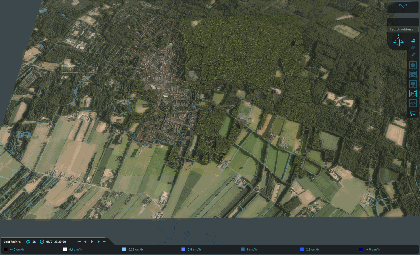Rain model (Water Overlay): Difference between revisions
No edit summary |
|||
| Line 8: | Line 8: | ||
It is possible to set up a dynamic rainfall definition, which allows for the amount of rainfall per period of time to vary over time. The default setup for rain consists of a single period of rain, and a single period without rain. More periods with varying amounts of rain (including zero rain for dry periods) can be defined, both for the weather's global rainfall definition, as well as for the overriding [[Rain area (Water Overlay)|Rain area]]s. | It is possible to set up a dynamic rainfall definition, which allows for the amount of rainfall per period of time to vary over time. The default setup for rain consists of a single period of rain, and a single period without rain. More periods with varying amounts of rain (including zero rain for dry periods) can be defined, both for the weather's global rainfall definition, as well as for the overriding [[Rain area (Water Overlay)|Rain area]]s. | ||
[[File:Wateroverlay_rainfall_areas_dynamic.gif|left|frame|Dynamic rainfall defined by 101 different rain areas, which is shown in the mini-map halfway the animation. Animation is showing the [[Last rain result type (Water Overlay)|last rain result]]]] | |||
==Example for dynamic rainfall== | ==Example for dynamic rainfall== | ||
Revision as of 12:25, 1 March 2024
Rain is modeled as an amount of precipitation that falls within a defined period of time, defined as a weather definition. It is configured as a series of a specific amount of water and a specific duration. These values are converted to an amount (mm) of precipitation per second. e.g. 15 millimeter of rain in 45 minutes matches would be converted to 0,0056 millimeter per second. The amount of rainfall added to a grid cell is obtained by multiplying the precipitation per second with the calculated timestep. At the end of the defined period, exactly the configured amount of rain will have fallen on each grid cell this rain was applied to.
For example, 15 millimeter of rain that falls in 45 minutes. In the Water Module this amount can be converted to an amount (mm) of precipitation per second. Moreover, the amount of rain per second that falls remains the same within the period it was defined for. At the end of the defined period of rain, it can be expected that the defined amount of rain should have fallen on each grid cell.
Rain is always added to the surface layer of a grid cell. For any specified period of rainfall, the amount of rain added to the grid cell is consistent. However, multiple periods of rain can be configured with varying durations and rain amounts.
The amount of rainfall is globally configured using the weather definition. If so configured, the definition for rainfall can be overwritten locally using Rain areas. For those areas, rather than the weather's rainfall, the overriding rainfall definition dictates the precipitation.
It is possible to set up a dynamic rainfall definition, which allows for the amount of rainfall per period of time to vary over time. The default setup for rain consists of a single period of rain, and a single period without rain. More periods with varying amounts of rain (including zero rain for dry periods) can be defined, both for the weather's global rainfall definition, as well as for the overriding Rain areas.

Example for dynamic rainfall
See the table below for an example of dynamic rainfall:
| Time key (minutes) | Amount of rainfall (mm/m2) |
|---|---|
| 35 | 15 |
| 42 | 19 |
| 120 | 5 |
This format can be interpreted as follows:
- The first period is starts at t=0 minutes and ends at t=35 minutes. In this first period, 15 mm/m2 of rain will fall. Uniformly this gives 15 / ((35 - 0) * 60) = 0.00714 mm per second.
- The second period starts at t=35 minutes and ends at t=42 minutes. In this period, 19 mm/m2 of rain will fall. Uniformly this is 19 / ((42 - 35) * 60) = 0.04524 mm rain per second.
- The last period starts at t=42 minutes and ends at t=120 minutes. In this period, 5 mm/m2 of rain will fall. Uniformly this is 5 / ((120 - 42) * 60) = 0,00107 mm rain per second.
In total it can be expected that per m2 15 + 19 + 5 = 39 mm rain has fallen in a total simulation time of 120 minutes.
Notes
- The configuration wizard is the easiest way to adjust rainfall.
- A dry period can be simulated by setting the amount of rain for a period to zero.
- Zero rain within a period is allowed, but negative is not. Negative values are interpreted as zero.
- The rainfall table is stored as the attribute array with the name RAIN_M. This attribute is part of the weather referenced by the Water Overlay.
- The underlying attribute array expects time to be defined in seconds.
- The last time key also determines the total simulation time.
- The next time key should always be larger than the previous time key.




